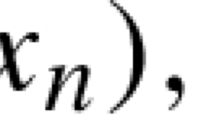Abstract
The sequences with strict superlinear convergence are the output of numerous algorithms; such speed is clearly much faster than linear, but is it also slower than, say, quadratic? In this note we show that actually there are four distinct classes of strict superlinear order: “weak”, “medium”, “strong” and “mixed”. The speed of the sequences from the first three classes is increasingly much faster (term-by-term big Oh, i.e., \(|x^*-x_k|=\mathcal {O}(|y^*-y_k|^{\alpha })\), as \(k\rightarrow \infty , \forall \alpha >1\) given), whereas the speed of the “mixed” class cannot be assessed. We prove that the speed of the sequences from the “medium” and “weak” classes is term-by-term slower than the speed of the sequences with high classical C-orders \(p>1\) (in the sense of big Oh above), while an example shows that certain sequences from the “mixed” class may be term-by-term faster than some sequences with infinite C-order. We also show that for a given sequence with strict superlinear convergence, one can evaluate numerically to which class it belongs. Some recent results of Rodomanov and Nesterov (Math Program 194(1-2, Ser. A):159–190, 2022), resp. Ye et al. [17] show that certain classical quasi-Newton methods (DFP, BFGS and SR1) belong to the “weak” class.


Similar content being viewed by others
Data availability
All data generated or analyzed during this study are included in this published article.
Availability of supporting data
Not applicable
Change history
07 September 2023
A Correction to this paper has been published: https://doi.org/10.1007/s11075-023-01658-y
Notes
\(q_l\) is taken \(\infty \) if \(\bar{Q}_p=0\), \(\forall p\ge 1\).
Recall that one cannot have \(Q_1=+\infty \) (as suggested by a typo in the abstract of [6]), but just \(\bar{Q}_1=+\infty \).
When \(\{x_k\}\) is starting from \(x_1\), \(\{a_k\}\) is starting from \(a_1\) (as, e.g., \(\{ \frac{1}{k^k}\}\), \(\{ \frac{1}{k}\}\), etc.).
References
Ortega, J.M., Rheinboldt, W.C.: Iterative Solution of Nonlinear Equations in Several Variables. SIAM, PA (2000)
Beyer, W.A., Ebanks, B.R., Qualls, C.R.: Convergence rates and convergence-order profiles for sequences. Acta Appl. Math. 20, 267–284 (1990)
Brezinski, C.: Vitesse de convergence d’une suite. Rev. Roumaine Math. Pures Appl. 30, 403–417 (1985)
Potra, F.A.: On Q-order and R-order of convergence. J. Optim. Theory Appl. 63(3), 415–431 (1989)
Cătinaş, E.: A survey on the high convergence orders and computational convergence orders of sequences. Appl. Math. Comput. 343, 1–20 (2019)
Cătinaş, E.: How many steps still left to \(x\)*? SIAM Rev. 63(3), 585–624 (2021)
Brezinski, C.: Accélération de la Convergence en Analyse Numérique. Springer-Verlag, Berlin (1977)
Potra, F.A., Pták, V.: Nondiscrete Induction and Iterative Processes. Pitman, Boston, Massachusetts (1984)
Tapia, R.A.: Diagonalized multiplier methods and quasi-Newton methods for constrained optimization. J. Optim. Theory Appl. 22(2), 135–194 (1977)
Polak, E.: Optimization. Algorithms and Consistent Approximations. Springer-Verlag, New York (1997)
Boggs, Paul T., Tolle, Jon W., Wang, Pyng: On the local convergence of Quasi-Newton methods for constrained optimization. SIAM Journal on Control and Optimization 20(2), 161–171 (1982)
Tantau, T.: The tikz and pgf packages. Manual for version 3.1.5b-34-gff02ccd1
Bezanson, J., Edelman, A., Karpinski, S., Shah, V.B.: Julia: a fresh approach to numerical computing. SIAM Review 59, 65–98 (2017)
Walker, H.F.: An approach to continuation using Krylov subspace methods. In: Periaux, J. (ed.) Computational Science in the 21st Century, pp. 72–81. John Wiley and Sons, Ltd. (1997)
Dennis, J.E., Jr., Moré, J.J.: A characterization of superlinear convergence and its application to quasi-Newton methods. Math. Comp. 28(126), 549–560 (1974)
Rodomanov, A., Nesterov, Y.: Rates of superlinear convergence for classical quasi-Newton methods. Math. Program. 194(1–2, Ser. A), 159–190 (2022)
Ye, H., Lin, D., Chang, X., Zhang, Z.: Towards explicit superlinear convergence rate for SR1. Math. Program. 199(1–2, Ser. A), 1273–1303 (2023)
Cătinaş, E.: Characterizing the classical convergence orders. Manuscript, submitted (2021)
Cătinaş, E.: Characterizing the classical linear convergence order Manuscript. (2021)
Cătinaş, E., Stan, A.: Measuring the measures. (2021). (manuscript)
Stan, A., Cătinaş, E.: Simpler proofs for the \(Q\)-order. Manuscript (2021)
Author information
Authors and Affiliations
Contributions
Not applicable
Corresponding author
Ethics declarations
Ethical approval
Not applicable
Conflict of interest
The author declares no competing interests.
Additional information
Publisher's Note
Springer Nature remains neutral with regard to jurisdictional claims in published maps and institutional affiliations.
The original online version of this article was revised: The additional correction in line 103 sent by the Author was not carried out.
Rights and permissions
Springer Nature or its licensor (e.g. a society or other partner) holds exclusive rights to this article under a publishing agreement with the author(s) or other rightsholder(s); author self-archiving of the accepted manuscript version of this article is solely governed by the terms of such publishing agreement and applicable law.
About this article
Cite this article
Cătinaş, E. The strict superlinear order can be faster than the infinite order. Numer Algor 95, 1177–1186 (2024). https://doi.org/10.1007/s11075-023-01604-y
Received:
Accepted:
Published:
Issue Date:
DOI: https://doi.org/10.1007/s11075-023-01604-y
Keywords
- Convergent sequence
- Convergence order
- Convergence speed
- Superlinear order
- Q-order
- Convergence rate
- Big Oh
- Quasi-Newton method
- DFP
- BFGS
- SR1



